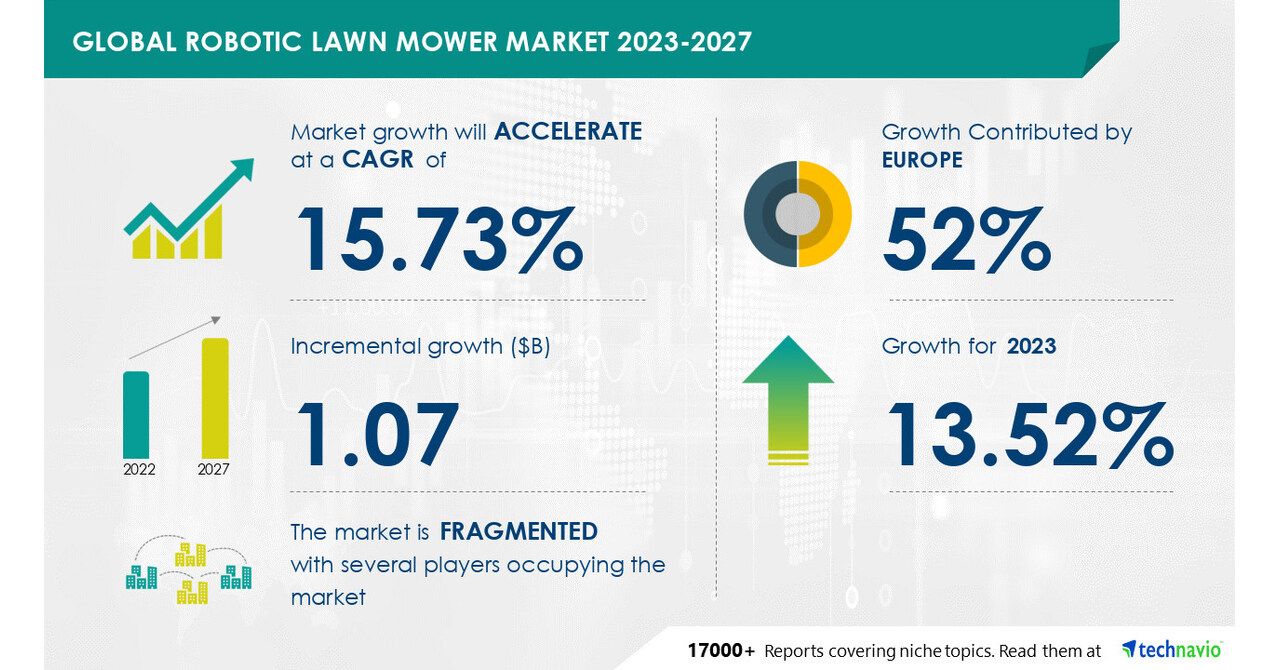# Review: Exploring the Global Robotic Lawn Mower Market
In the ever-evolving landscape of technology, the global robotic lawn mower market is experiencing significant growth, with an estimated increase of USD 1.07 billion from 2023 to 2027. According to Technavio, the market is projected to grow at a CAGR of over 15.73% during the forecast period. This growth is driven by various factors, including the development of smart cities, urbanization trends, and the increasing demand for aesthetically pleasing outdoor spaces. In this review, we will delve into the key drivers, challenges, market structure, and regional analysis of the robotic lawn mower market, as well as explore the segment overview and research analysis provided by Technavio.
## Market Driver: The Rise of Smart Cities and Urbanization
One of the primary trends fueling the growth of the robotic lawn mower market is the development of smart cities. As urbanization continues to reshape our cities, the demand for advanced mowing solutions has increased, especially among urban households with lawns. These solutions are equipped with features like barrier recognition systems, lawn mapping, and memory for precise mowing, catering to various lawn sizes. The importance of well-manicured lawns is underscored by activities such as sports, garden gatherings, and outdoor cooking, driving the demand for robotic lawn mowers with advanced features like smartphone connectivity, artificial intelligence, and integration with smart home systems.
## Market Challenges: Availability of Alternatives
Despite the growth in demand for robotic lawn mowers, the market may face challenges due to the availability of alternatives such as traditional lawn mowers. However, the market is buoyed by the increasing ownership of lawns among households and the desire for advanced features like precision mowing, smartphone control, and smart home integration. Leading brands like Husqvarna and Worx offer robotic lawn mowers with features that cater to different lawn sizes and enhance user experience. While initial costs may be higher, the operational efficiency and aesthetic appeal of robotic lawn mowers justify their investment for households and commercial properties.
## Segment Overview: Residential and Commercial Markets
The robotic lawn mower market is segmented into residential and commercial markets, with the residential segment witnessing gradual growth driven by urban households’ preference for grass lawns. Companies like Mammotion are expanding their product offerings to meet the needs of homeowners with expansive properties. Advanced features like barrier recognition systems, lawn mapping, and memory for precise mowing are becoming standard in robotic lawn mowers, catering to the demands of modern households. The market also caters to lawns of varying sizes, from small to large, with battery-powered systems dominating the 20V voltage segment.
## Research Analysis: Advancements in Lawn Maintenance Technology
In the contemporary landscape of lawn maintenance and home gardening, robotic lawn mowers have emerged as game-changers, offering labor cost savings, visual appeal enhancement, and integration with smartphone applications and Bluetooth technologies. These intelligent machines employ artificial intelligence and precision mowing techniques to optimize lawn care, even on uneven terrains. The market continues to expand, driven by advancements in AI and the growing preference for eco-friendly, smart tools.
## Conclusion
The global robotic lawn mower market is poised for significant growth, driven by the development of smart cities, urbanization trends, and the increasing demand for advanced lawn care solutions. With key players like Husqvarna, Worx, and Mammotion leading the market with innovative features and technologies, the future of robotic lawn mowers looks promising. As the market continues to evolve, advancements in AI, smart home integration, and battery-powered systems will play a crucial role in shaping the landscape of lawn maintenance technology.
In conclusion, the global robotic lawn mower market presents exciting opportunities for both residential and commercial users, offering advanced features, efficiency, and convenience in lawn care. As the market continues to grow, it will be interesting to see how technological advancements and consumer preferences shape the future of robotic lawn mowers.
—
This engaging review provides a comprehensive overview of the global robotic lawn mower market, highlighting key drivers, challenges, market structure, and regional analysis. The segment overview and research analysis offer valuable insights into the growth and trends shaping the market. With a focus on technological advancements and consumer preferences, this review captures the dynamic landscape of the robotic lawn mower industry.

